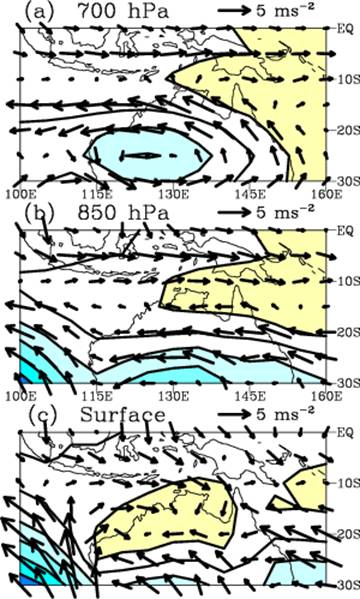| Article Index |
|---|
| Theme 2 |
| Project 2.1 |
| Project 2.2 |
| Project 2.3 |
| Project 2.4 |
| All Pages |
Project 2.3: Statistical Downscaling for the North West (Steve Charles)
Statistical downscaling uses large-scale predictors such as mean sea-level pressure to build a statistical model of the expected local rainfall or temperature on a certain day. Few downscaling models have been developed for the tropics. To develop such a tool the major predictors must first be identified. In the tropics, unlike in the sub-tropics, mean sea-level pressure is not necessarily representative of the features aloft, thus the winds must be used at several levels to best describe the atmosphere.
Planned outcomes:
- Analyse and model historical multi-site daily rainfall, for a network of high quality stations in the North West, to provide an understanding of the dominant patterns of rainfall variability and their trends and shifts over recent decades.
- Calibrate statistical downscaling models to identify the dominant large-scale atmospheric drivers of the historical rainfall variability, trends and shifts.
- Assess climate models for their ability to reproduce these drivers, thus allowing selection of the better performing climate models to be used for generating climate change projections of multi-site rainfall for the region to 2100.

Figure 2.3.1: The mean summer (December to March) winds are shown at three levels, from the surface (c) through levels higher up (b) and (a). The shaded regions correspond to the mean sea-level pressure at the surface (c), (contour interval is 2hPa and the yellow shaded area is values below 1008 hPa), and the height of the atmosphere at the designated pressure level in (a), (contour interval 10 m, and heights below 3130 m shaded yellow) and (b), (contour interval is 8 m and regions below 1492 m shaded yellow). The data is from the NCEP/NCAR reanalyses.
Previous work assessing which are the best predictors for local tropical rainfall and temperature from global climate models found that while upper level level winds are useful, direct model results of the variables predicted add further skill. For example, direct model output large-scale rainfall is a good predictor for local rainfall.
Reference
Timbal, B., Li, Z. and Fernandez, E., 2008: The Bureau of Meteorology Statistical Downscaling Model Graphical User Interface: user manual and software documentation. CAWCR technical report, 4, 90pp. http://www.cawcr.gov.au/publications/technicalreports.php




